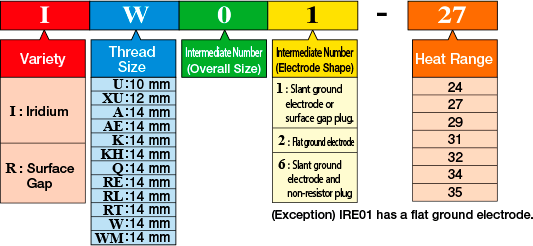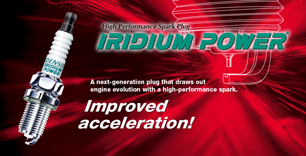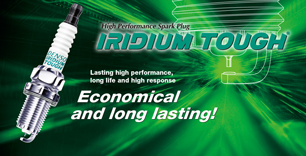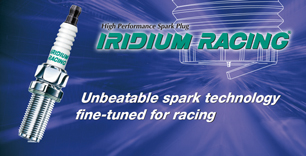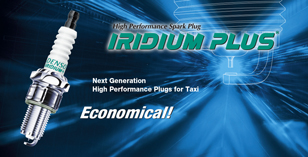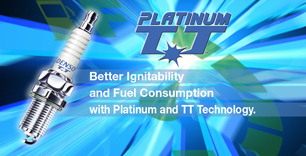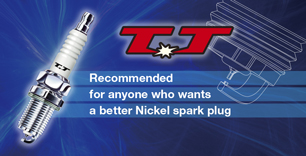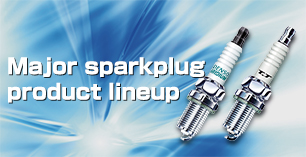Identifying DENSO Plugs
IRIDIUM POWER Series (Power, Tough, Plus) & TT
High Performance Plug
| I | ······· | 0.4 mm diameter iridium <POWER> |
|---|---|---|
| V | ······· | 0.4 mm diameter iridium with platinum tip <TOUGH> |
| VF | ······· | 0.4 mm diameter iridium with 0.7 mm needle type platinum tip <TOUGH> |
| VD | ······· | 0.7 mm diameter iridium with 0.7 mm needle type platinum tip <TOUGH> |
| P | ······· | 1.1 mm platinum center electrode |
| VS | ······· | 0.7 mm diameter iridium with platinum tip <TOUGH> |
Thread Diameter, Reach, and Hex Size
|
|
Heat Range
| DENSO | NGK | CHAMPION | BOSCH |
|---|---|---|---|
| 16 | 5 | 12,11 | 8 |
| 20 | 6 | 10,9 | 7,6 |
| 22 | 7 | 8,7 | 5 |
| 24 | 8 | 6,63,61 | 4 |
| 27 | 9 | 4,59 | 3 |
| 29 | 9.5 | 57 | |
| 31 | 10 | 55 | 2 |
| 32 | 10.5 | 53 | |
| 34 | 11 | ||
| 35 | 11.5 |
Shape (Type)
|
|
Iridium Plugs / Platinum Plugs / Normal Plugs
Type of precious metal
| D | ······· | 0.7 mm diameter iridium with 0.7 mm needle type platinum |
|---|---|---|
| F | ······· | 0.55 mm diameter iridium with 0.7 mm needle type platinum |
| P | ······· | 1.1 mm diameter platinum with platinum tip |
| S | ······· | 0.7 mm diameter iridium with platinum tip |
| SV、V | ······· | 0.4 mm diameter iridium with platinum tip |
| Z | ······· | 0.55 mm diameter iridium with platinum tip |
| E | ······· | 0.7 mm diameter iridium with 1.0 mm needle type platinum |
Thread Diameter and Hex Size
|
|
Heat Range
| DENSO | NGK | CHAMPION | BOSCH |
|---|---|---|---|
| 4 | |||
| 9 | 2 | 18 | 10 |
| 14 | 4 | 16,14 | 9 |
| 16 | 5 | 12,11 | 8 |
| 20 | 6 | 10,9 | 7,6 |
| 22 | 7 | 8,7 | 5 |
| 24 | 8 | 6,63,61 | 4 |
| 27 | 9 | 4,59 | 3 |
| 29 | 9.5 | 57 | |
| 31 | 10 | 55 | 2 |
| 32 | 10.5 | 53 | |
| 34 | 11 | ||
| 35 | 11.5 |
Reach
|
|
Shape (Type)
|
|
Shape (Type)
|
|
Gap
|
<None> Cars: 0.8 mm M/C: 0.7 mm
<Exceptions> P16R, PQ16R, PQ20R are 1.1 mm
IRIDIUM RACING
Warning: On choosing the right racing plug
- Generally, electrodes that project into the combustion chamber have better ignitability and have better performance. However, because of more exposure to high temperature combustion gases and because ground electrode becomes longer, heat resistance and durability decrease. The higher the level of tuning, the greater the need is to use a less projecting type.
- As the level of tuning is increased, so does the need for higher heat range.
